What is a fan coil: operating principle and rules for installing a fan coil
When choosing an air conditioning and heating system for your home, it makes sense to find out what a fan coil is, what functions the climate control device performs, and in what situations it is advisable to use it.
In the article we provided detailed answers to the above questions. From the material you will learn how it works, what elements a fan coil consists of, what types of fan coil units exist and what their features are.
We indicated the rules for placing climate control equipment, and also described the specifics of installing equipment in a private house and apartment.
The content of the article:
Operating principle of a fan coil
The name of the device comes from two English words: “fan” - fan and “coil” - coil. These basic elements ensure the operation of the device. A system using such devices is usually used to organize multi-zone air conditioning in large rooms.
The fan drives air currents through the heat exchanger. Depending on the task at hand, hot or cold water enters the heat exchanger coil. The air heats up and spreads throughout the room.
One of the advantages of using fan coils is the ability to not only heat and cool indoor air, but also dilute it with fresh air from the street.
This option is not difficult to implement if you plan to use forced supply ventilation.
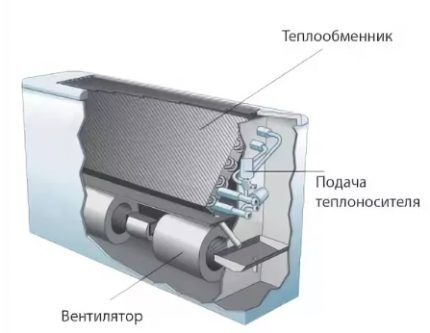
The fan coil consists of the following elements:
- coil-heat exchanger;
- fan;
- filtration block.
The system can include only one heat exchanger or two at once to ensure easy transition to another operating mode.
In the latter case, one circuit is connected to chiller - a refrigeration machine that generates a flow of cold water, and the second - to a heating boiler or other similar heating device. The combination of fan coil units with a heat pump is very popular.
It is worth noting that if the decision is made to use chiller-fan coil system, then you can install several fan coil units in different rooms, and only one chiller will work for them.
The solution looks very convenient for buildings that need to serve a large area. But at the same time, it is necessary to correctly calculate the performance of the chiller depending on the number and characteristics of fan coil units.

For the fan to operate, each device must be supplied with power. To clean air masses and improve the indoor microclimate, it is necessary filter block.
Each fan coil is equipped with a control system, which, depending on the type of device, can be built-in, remote or remote.
In addition, to install fan coils you will need a set of couplings, insulating materials, etc. It is mandatory for a system of this type to install drainage to ensure the removal of condensed moisture.
The use of fan coil units gives significant freedom when designing the system.You can always select a chiller and/or boiler with suitable power and install the required number of fan coil units. Installation is relatively inexpensive, since ordinary water pipes are used for the coolant.
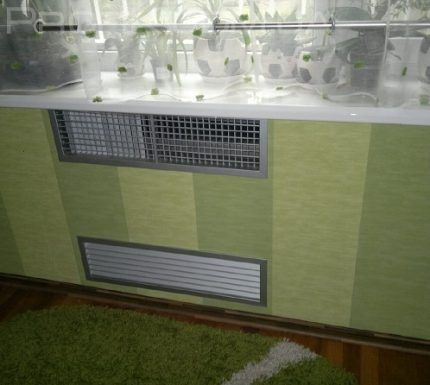
The system takes up relatively little space; if desired, fan coil units and communications leading to them can be completely hidden behind a suspended ceiling.
If we consider fan coil units as an alternative to a split system, then they have an important advantage - they allow you to keep the appearance of the facade unchanged.
The device for cooling and/or heating water can be placed at a considerable distance from the fan coil units. If the installation is carried out correctly and the line is equipped with reliable thermal insulation, the system will work efficiently. This can be convenient, especially if the building has a complex layout.
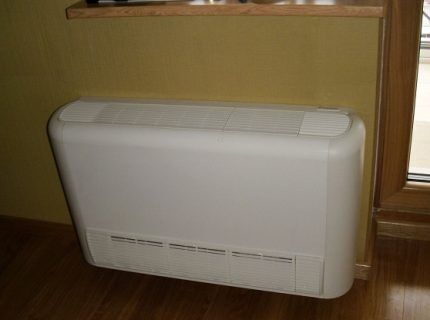
The use of ordinary water pipes, rather than expensive special pipes, significantly reduces the cost of the system and simplifies installation. Automation of a “chiller-fan coil” type system is performed in approximately the same way as for a split system: using a remote control.
This allows you to adjust parameters not for the entire building, but separately for each room in which there is a fan coil unit.
How far can a fan coil unit be removed from a source of heat or cold? This distance is determined by the power of the pump, which moves the coolant liquid through the pipes of the system.The higher the pump power, the longer the distance can be.
This significantly expands the number of options for installing both the fan coil units themselves and the boiler and/or chiller. The limit figure is considered to be 600 m, and this is a more than respectable figure.
The fan coil system can also be used in combination with such an economical and environmentally friendly method of generating energy as a heat pump. In this case, it is possible to organize not only a single-circuit, but also a double-circuit heating system, i.e. provide the house with hot water.
If the system is thought out and implemented correctly, then a comfortable temperature will be established in the room within five minutes after startup.
What types of fan coils are there?
The type of fan coil depends on the tasks that need to be solved with its help. There are two-pipe and four-pipe devices. The former can only work for heating or cooling, the latter are capable of solving both problems.
Both the heater and the chiller are connected in parallel to four-pipe fan coils. The operating mode of the system is selected depending on the time of year and needs.

However, there is an option when a two-pipe system is used for air conditioning in the summer, and then for heating in the winter. In this case, the system is switched either to a chiller or to a boiler using a special valve; changing the operating mode of the system is done manually.
This is a fairly popular version, since installing only two pipes is much easier than installing four structures.
Switching operating modes when using a four-pipe system can be performed from the control panel in automatic mode.
Depending on the installation location, fan coil units are distinguished:
- floor;
- wall;
- floor-ceiling;
- ceiling
The purpose of each type of device is clear from the name. Wall-mounted fan coil units most often serve as an alternative to conventional radiators for a water heating system. They are also installed along the walls under windows or in other similar places. Floor-ceiling models can be installed both above and below.
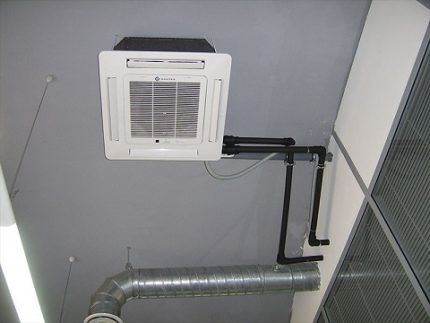
In addition, there are cassette and duct fan coil designs. Devices can also be cased or uncased, designed for hidden installation. This is another advantage of fan coil units: they make the heating/air conditioning system virtually invisible.
Some models are equipped with additional functions, for example, a fresh air intake system from outside, the ability to electrically heat air masses using built-in heating elements. Options for organizing the management system can also be different.

As for specific brands, fan coil units manufactured by Carrier And York. The company's models demonstrate excellent qualities Trane, and McQuay, these are reliable devices made in Europe.
General Climate presents a wide range of fan coil units in various configurations.And the company's models Daikin According to the owners, they look very stylish. Among the inexpensive products, fan coil units stand out Aerotek is a popular Chinese brand.
Features of installation of such equipment
Installing a fan coil unit is not an easy task. If the home owner does not have much experience in installing heating and/or refrigeration equipment, it is better to turn to professionals. First, the fan coil itself is installed. The installation location depends on the type of device: ceiling, floor, wall.
In any case, it is necessary to ensure the free movement of air masses from the fan coil throughout the room for the device to operate effectively.
After installing the fan coil unit, it is necessary to assemble the piping unit, install pipes and lay a layer of thermal insulation. A number of elements such as shut-off valves, temperature sensors, pressure gauges, etc.
Rubber-coated pipes may be an excellent option for installing this type of system. They are compact and have good thermal insulation properties.
Mounted if necessary air ducts. These structures should be equipped with sound insulation. To ensure that water is distributed evenly throughout the system and its correct hydraulics are ensured, balancing valves are used.
The presence of these devices greatly simplifies setting up the system, since regardless of its configuration, the same water pipes can be used everywhere.
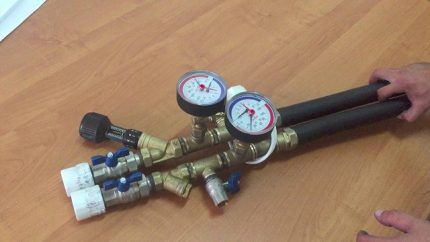
When drawing up a system design, it is necessary to take into account the length of the air ducts, which is strictly standardized.This is especially true when installing wall-mounted fan coil units under windows. Steel air ducts are equipped with a vibration muffler. A condensate collection and drainage system must be installed.
Trays for collecting moisture should be secured under the corresponding openings. After this, the fan and electric heaters (if any) are connected to the power supply. Then all contacts, channels and pipes are checked for leaks.
After this, the system is launched and pressure tested to check the quality of installation. If there are no flaws, you can continue finishing work.

The easiest way to cope with the installation of a floor-mounted fan coil unit. It does not require installing a condensate drainage channel. The device has two pipes that are connected to the corresponding device.
When installing wall, ceiling and cassette models, the connection to the electrical network is made according to a more complex scheme than for a floor-standing fan coil unit.
In any case, installing a four-pipe system will be the most difficult. To install any type of system, it is important to correctly perform the design and a number of special calculations.
Installing a fan coil in an apartment
Devices of this type can be called universal to a certain extent. If you follow some recommendations, fan coils can be successfully installed even in ordinary apartments.
For small areas, you can use only one fan coil unit, from which warm (or cold) air is distributed throughout the apartment through an air duct system.
A fan coil unit is usually installed in the hallway or in the bathroom; the pipes can be hidden under a suspended ceiling. Of course, the ceiling at the location where the main device is installed will have to be lowered, which is not always convenient in apartments with low room heights.
However, in other rooms the problem can be eliminated by creating a two- or even three-level ceiling to hide less bulky air ducts.
The location of the fan coil is determined not only by the size of the device. During operation, the unit produces a significant amount of noise, which is unlikely to be appropriate in residential premises. To service the entire apartment, you will have to take a fairly powerful fan coil, and the more efficient the device, the more noise it makes.
Of course, a system with only one fan coil will be relatively inexpensive, and installation will not be too difficult. However, in this case, the advantage of climatic multizonality, characteristic of larger systems, is lost.
It will be possible to regulate the operation of the fan coil unit using the remote control, but the selected mode will apply to all rooms. This is not very convenient if the windows of the rooms face different sides and are heated by the sun differently.
An alternative option is to install a small fan coil unit in each room or only in some rooms. In this case, it will be much easier to regulate the microclimate in individual rooms.
Smaller devices will generate less noise and their impact can be significantly reduced by choosing the right installation location and using noise suppression measures.
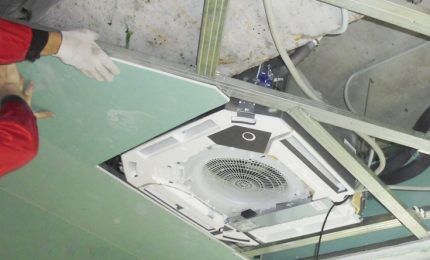
Of course, installing such a system will not be cheap. Two or three fan coil units can be installed as in the first option - in the hallway, and then the air ducts can be routed to different rooms. In this case, the noise problem is even easier to solve. In the future, it is enough to adjust each fan coil to obtain the appropriate temperature in individual zones.
Such systems can be used in combination with forced supply ventilation. They will not only change the air temperature, but also update its composition. To remove condensation that appears during operation, special pumps are used that pump moisture into the sewer system.
Conclusions and useful video on the topic
This video describes the operating principles of fan coil units and the installation features of such devices:
In residential construction, fan coil units are increasingly being used effectively. It is very important to properly design and implement the installation of a fan coil to ensure its trouble-free operation over a long period of time.
Do you have anything to add, or do you still have questions about the selection, operation and installation of a fan coil? Please leave comments and participate in discussions. The contact form is located below.




Absolutely agree. When choosing a fan coil unit, you need to make sure that it consumes electricity in moderate quantities and does not create noise. I recommended to my clients to also pay attention to appearance, since aesthetics also plays an important role. The environmental friendliness of the installation is a great advantage if a chiller and fan coil are used together.
A very good solution to problems with ventilation and heating in one device.Probably the best option is to take a device that can both heat and cool the air in the room. This can save a lot of money on air conditioning systems. There is no need to install a separate unit in each room. Although there are difficulties in the installation process. Installing the system in a residential area after finishing will be problematic.
Hello, please help me, there is such a weak fankol blowing in my room,